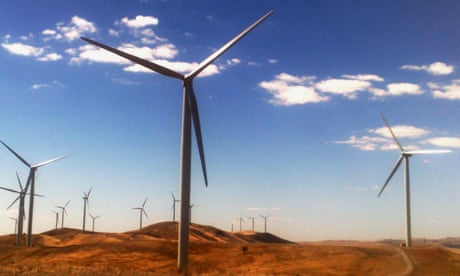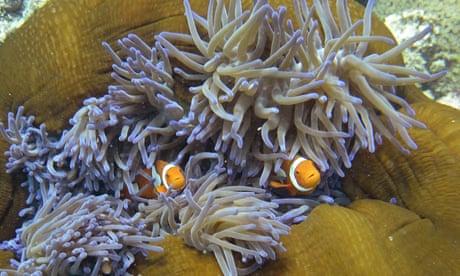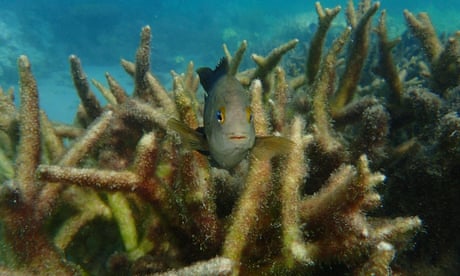And the cost of doubling the world's total output of clean energy by 2030 would be lower than a "business as usual" approach because of the stunning production costs.
| The winds of change: renewables are set to give coal a run for its money. |
A new report by the International Renewable Energy Agency (IRENA), an intergovernmental organisation, says the cost of solar photovoltaics (PV) could be slashed by 59 per cent by 2025 to 6 US cents per kilowatt hour.
The cost of offshore wind could reduce by as much as 35 per cent in less than a decade, with the cost of onshore wind slashed by 26 per cent.
| Bill Shorten dances with locals during a trip to Kiribati to raise awareness of climate change. Photo: ABC |
Mr Taylor said the rapid deterioration in the costs of wind and solar energy meant that Australia, blessed with both, was poised to produce low-cost electricity.
"In Australia, with the quite high retail electricity prices you've seen, renewables is now a highly competitive opportunity for Australia and to focus on resource extraction to the extent of all else perhaps should be re-evaluated," he said.
"It's obviously a debate for Australia to have, but what we can say in terms of the transition and the economics is that it's definitely one we encourage Australia to have."
The research follows BP's annual review of world energy, which found "rapid technological gains" have supported strong growth for solar and wind power. Both recorded "solid growth" in 2015 "at the expense of coal."
The report calculated global renewable energy consumption to be 2.8 per cent, up from 0.8 per cent a decade ago.
Renewables accounted for 6.7 per cent of global power generation, with China recording a whopping 21 per cent growth and Germany 23 per cent. Coal's share of global primary energy consumption fell to its lowest level since 2005 at 29 per cent.
'Coal is a very important part of the energy agenda'
Shortly after becoming prime minister, Malcolm Turnbull lauded Australia's "cleaner coal" as one solution to "energy poverty."
He noted the rapid advances being made in wind and solar, but said "coal is a very important part of the energy agenda" and he rejected calls for a moratorium on new coal mines.
Opposition leader Bill Shorten has also rejected such calls, telling the leaders of Pacific countries affected by rising sea levels that he had "made it very clear Labor is not going to stop coal mining."In June 2015, the Liberal and Labor parties agreed to lower the Renewable Energy Target from 41,000 gigawatt hours of renewable energy supply by 2020 to 33,000 GW-hours or 23.5 per cent. This followed a push from within the Coalition to abolish or drastically cut the renewable energy target.
Many Liberals deny the science of climate change, while others believe the renewable energy sector should rely less on government mandates and subsidies.
The Coalition government's decision to abolish the carbon price has led to a 5.6 per cent increase in emissions from the electricity sector.
Mr Shorten wants half of Australia's energy produced by renewables by 2030, but has only committed to a goal and not a mandated target.
Costs lower than business than usual
Mr Taylor said the new analysis showed the world could double its output of clean energy by 2030 and stay on target for reaching its climate change goals. He said that scenario would still cost less than current policies centred on coal.
"Once you take into account the environmental costs that would be avoided ... and the fact that costs have come down, it would be less than business as usual," he said. "There are net economic benefits for this transition."
And he said IRENA's estimates of the cost reductions were on the conservative side.
"If history has told us anything with renewables, you can be quite optimistic and we can still be surprised," he said.
"No-one anticipated the rapid decline [in the costs of] solar PV modules that we saw between 2009 and 2013 – that wasn't part of the orderly plan in the transition, but it happened," he said.
Mr Taylor said energy policies over the next 15 years would be critical."We're in a critical phase – the cost of renewables has come down dramatically," he said.
"The decisions we make over the next five to 10 years are going to be critical to how successful we are in avoiding dangerous climate change."
Links


 By anyone's reckoning, the CEFC has been a success. According to its
2015 annual report, it invested $1.4bn, financing projects worth a total
of $3.5bn, which would reduce 4.2m tonnes of CO2-equivalent emissions
annually. And it did all that while making a profit.
But under the Tony Abbott, who called the CEFC "Bob Brown's bank", the Coalition tried unsuccessfully to abolish it,
By anyone's reckoning, the CEFC has been a success. According to its
2015 annual report, it invested $1.4bn, financing projects worth a total
of $3.5bn, which would reduce 4.2m tonnes of CO2-equivalent emissions
annually. And it did all that while making a profit.
But under the Tony Abbott, who called the CEFC "Bob Brown's bank", the Coalition tried unsuccessfully to abolish it, 

